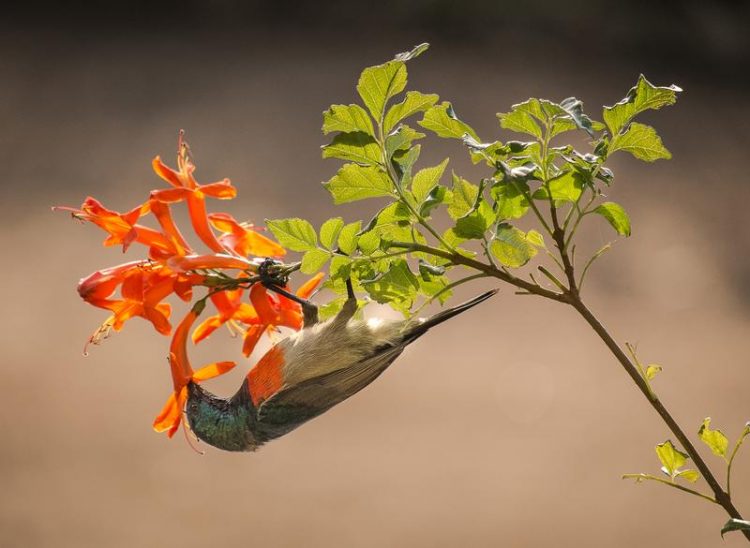Animals and plants jointly conduct their coexistence

Sunbird at flower Copyright: Eike Lena Neuschulz
The tropical rainforest with its permanently wet climate brims over with an abundance of plant species. Flowers of all sizes with shallow to deep tubes offer a wide variety of food sources to pollinators. Sunbirds, for example, developed long, down-curved beaks enabling them to reach the nectar at the bottom of long tubes. But who is the leading actor in this interplay of plants and animals?
“Ecosystems with high precipitation typically contain a wide variety of plants and show a high level of functional diversity. The higher this functional diversity, the more their animal partners are able to specialize on particular plant species. The plants therefore serve as the deciding factor for the animals’ specialization,” explains Dr. Jörg Albrecht of the Senckenberg Biodiversity and Climate Research Center, lead author of a new study regarding this topic.
In the context of this study, Albrecht and his colleagues from Germany, Switzerland and Tanzania observed and analyzed almost 15,000 interactions between plants, their pollinators and their seed dispersers over a period of five years. The study area comprised survey plots from the foothills of the Kilimanjaro up to the mountain’s summit.
Since 2010, an international team of scientists in the joint project “Kilimanjaro ecosystems under global change,” sponsored by the German Research Foundation, has been working here to find out how climate and land use affect the biological diversity on Africa’s tallest mountain.
However, on Kilimanjaro it is not always the plants who make the rules. The newly published study shows that there also exist climatic conditions in which the animals set the agenda. Albrecht explains, “Mean temperature is more important than precipitation for animal diversity. In cold climates, animal species tend to resemble each other more closely and show a lower level of functional diversity. Therefore, in cold regions plants are not able to specialize on specific animal partners and frequently interact with the same species.”
Since the amount of precipitation and the mean temperature in many areas is expected to change due to climate change, researchers suspect that changes will also occur in the networks between plants and animals. “Depending on how the climate will change in a particular region, either plants or animals could drive the structure of these networks in the future. A change in the flora could thus also have an impact on the animal partners of the plants,” explains the study’s senior author, Dr. Matthias Schleuning of the Senckenberg Biodiversity and Climate Research Center.
According to the authors, the ability of species to adapt to new environmental conditions is not only determined by the species themselves, but also depends on the responses of their plant or animal partners. Precise predictions regarding future changes in biodiversity are essential to mitigate future environmental changes caused by climate change. “In order to better predict how species and ecological communities will respond to global change, it is important to consider the environmental conditions together with the mutual interdependencies between species,” summarizes Matthias Schleuning.
Contact
Sabine Wendler
Press Officer
Senckenberg Biodiversity and Climate Research Centre
Phone +49 (0)69 7542 1818
pressestelle@senckenberg.de
Press images may be used at no cost for editorial reporting, provided that the original author’s name is published, as well.
The images may only be passed on to third parties in the context of current reporting.
Press releases and press images are available at www.senckenberg.de/presse
To study and understand nature with its unlimited diversity of living creatures and to preserve and manage it in a sustainable fashion as the basis of life for future generations – that has been the goal of the Senckenberg Gesellschaft für Naturforschung (Senckenberg Nature Research Society) for the past 200 years. This integrative “geobiodiversity research” and the dissemination of research and science are among Senckenberg’s primary tasks. Three nature museums in Frankfurt, Görlitz and Dresden display the diversity of life and the earth’s development over millions of years. The Senckenberg Gesellschaft für Naturforschung is a member of the Leibniz Association. The Senckenberg Nature Museum in Frankfurt is supported by the City of Frankfurt am Main as well as numerous other partners.
Additional information can be found at www.senckenberg.de
PD Dr. Matthias Schleuning
Senckenberg Biodiversity and Climate Research Centre
Phone +49 (0)69 7542 1892
matthias.schleuning@senckenberg.de
Sabine Wendler
Press Officer
Senckenberg Biodiversity and Climate Research Centre
Phone +49 (0)69 7542 1818
pressestelle@senckenberg.de
Albrecht, J. et al. (2018): Plant and animal functional diversity drive mutualistic network assembly across an elevational gradient. Nature Communications, doi: 10.1038/s41467-018-05610-w
Media Contact
All latest news from the category: Life Sciences and Chemistry
Articles and reports from the Life Sciences and chemistry area deal with applied and basic research into modern biology, chemistry and human medicine.
Valuable information can be found on a range of life sciences fields including bacteriology, biochemistry, bionics, bioinformatics, biophysics, biotechnology, genetics, geobotany, human biology, marine biology, microbiology, molecular biology, cellular biology, zoology, bioinorganic chemistry, microchemistry and environmental chemistry.
Newest articles

Silicon Carbide Innovation Alliance to drive industrial-scale semiconductor work
Known for its ability to withstand extreme environments and high voltages, silicon carbide (SiC) is a semiconducting material made up of silicon and carbon atoms arranged into crystals that is…

New SPECT/CT technique shows impressive biomarker identification
…offers increased access for prostate cancer patients. A novel SPECT/CT acquisition method can accurately detect radiopharmaceutical biodistribution in a convenient manner for prostate cancer patients, opening the door for more…

How 3D printers can give robots a soft touch
Soft skin coverings and touch sensors have emerged as a promising feature for robots that are both safer and more intuitive for human interaction, but they are expensive and difficult…





















